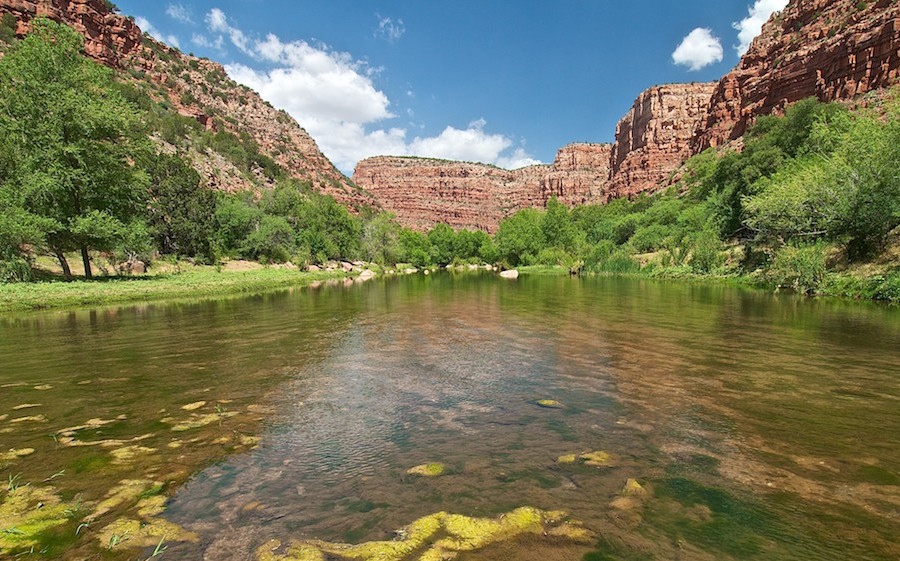Learn
A future healthy, flowing river – it’s our choice
Groundwater currently supplies almost all residential and municipal water needs in the upper Verde River Watershed – the Prescott area, Big Chino Valley, Chino Valley, and part of Prescott Valley – and the Verde Valley within the middle Verde River Watershed. The upper and middle Verde River watersheds provide the groundwater that sustains year-round flow of the Verde River and its perennial tributaries, their crucial riparian functions, and agricultural irrigation in the Verde Valley. Reports of the U.S. Geological Survey clearly show that pumping of groundwater that began in these areas in the 1900s has lowered and will continue to lower groundwater tables and to decrease perennial streamflow of the Verde River. Additional groundwater pumping without mitigation will amplify both effects.
What are some of the expected eventual consequences of pumping ever more groundwater to supply future needs?
Eventual Consequences:
- Dry stretches and irreparable damage to the Verde River.
- Loss of surface-water use by water-right holders that include agricultural irrigators in the Verde Valley and, farther downstream, irrigators and municipalities in parts of Maricopa County.
- Loss of riparian habitat and associated wildlife.
- Increasing loss of once-productive domestic wells as water tables decline.
- Necessity to deepen or relocate some currently productive municipal wells.
- Economic loss as damage to the river increases and assurance of adequate water for human use decreases.
Concern is growing in Arizona’s major metropolitan areas about impending water-supply problems from threatened reductions in the delivery of Colorado River water. At the same time, there is little if any plan at the state level to deal with declining future water resources in rural areas such as the Upper and Middle Verde River Watersheds. We in the Verde River Basin are essentially on our own and have little choice but to live within our means by fulfilling future water-resource needs from within our own resources.
What tools might we apply regionally, as connected watershed communities, to protect our shared groundwater and live within our means?
Tools to help preserve the flow:
- Conservation, especially by installation of or conversion to low water-use landscaping (xeriscaping).
- Maximized use of treated wastewater for groundwater recharge, irrigation, or other non-potable use (for example, treated wastewater returned via purple pipe for toilet flushing).
- Roof-top rainwater harvesting at residences and businesses. Average annual rainfall ranges from about 13 inches in Chino Valley, Cottonwood, and Camp Verde to about 18 inches in Prescott and Sedona. One inch of water harvested from rainfall on a single 1,000 square-foot roof would provide approximately 620 gallons of water that could be used for non-potable uses such as yard irrigation, laundry, or toilet flushing. An alternative where geologic conditions permit would be aquifer recharge via dry wells that capture roof drainage from the downspouts.
- Collection of runoff from hard surfaces such as roads, driveways, and parking areas in residential developments and business lots or business parks could be substantial and, water-quality permitting, would most likely be directed to aquifer recharge.
- Capture of flood-water runoff to support aquifer recharge, for example, via check dams along normally-dry washes where geologic conditions would permit infiltration or by diversion to infiltration basins.
- Purchase of development rights (also known as conservation easement) programs to financially compensate willing landowners for not developing their land. This is a tool that can benefit both landowners and communities while simultaneously protecting groundwater, wildlife habitat, and farming or ranching.
The regional application of any one of these tools has cost and considering each one individually is insufficient to fully prevent further decline of water tables. Additionally, each one requires, to varying degrees, technical evaluation, public acceptance, political support, and/or regulatory change. However, meeting the costs and applying these tools as appropriate across our watersheds may reduce or eliminate a need to apply stringent regulation of groundwater pumping as the only solution. Application of such tools is surely preferable to failing to meet the future water needs of our citizens and losing the aesthetic, ecological, recreational, and economic benefits of a free-flowing, perennial Verde River.
Article by Ed Wolfe, with contributions from Marianne Davis
Upper Verde River Photo by Gary Beverly






